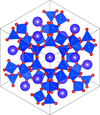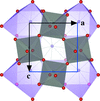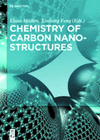issue contents
June 2018 issue

Cover illustration: VESTA plot of the ![]() crystal structure of dry-synthesized K2ZnSi5O12 looking down [111], see Bell & Henderson [(2018). Acta Cryst. B74, 274-286].
crystal structure of dry-synthesized K2ZnSi5O12 looking down [111], see Bell & Henderson [(2018). Acta Cryst. B74, 274-286].
research papers
The differences in crystallographic parameters of various phosphine–borane pairs have been described. It was found that truly frustrated Lewis pairs could not be isolated. This report also suggests a revising of the nomenclature of the pairs.
A theory of order–disorder phase transitions of B-cations in AB′1/2B′′1/2O3 perovskites is developed which allows reliable estimation of the phase transition temperatures and of the reduced lattice constants of such compounds.
Download citation


Download citation


Crystal structures for synthetic analogues of the tectosilicate mineral leucite (KAlSi2O6) with stoichiometries of K2X2+Si5O12 (X = Fe2+, Co, Zn) and Rb2X2+Si5O12 (X = Mn) were refined from X-ray powder diffraction data. Structures refined in P21/c have ordered Si and X cations on the tetrahedral sites, whereas structures refined in  have disordered Si and X cations. These leucite structures show an inverse relationship between the tetrahedral T—O distances and the intertetrahedral T—O—T angles.
have disordered Si and X cations. These leucite structures show an inverse relationship between the tetrahedral T—O distances and the intertetrahedral T—O—T angles.
Download citation


Download citation


The solid-state structure of a star-shaped triazine compound is determined from a powder sample by exploiting the respective strengths of single-crystal electron diffraction and powder X-ray diffraction data, confirming that the symmetry of the crystal packing allows for nonlinear optical effects.
CCDC reference: 1492552
Download citation


Download citation


The structure of the low-temperature polar (orthorhombic) phase of russellite (Bi2WO6) was re-examined with single-crystal X-ray diffraction. The position of the stereochemically-active lone pair of electrons of bismuth was found on a line running through the Bi sites in the b-axis direction. The ferroelectricity of the compound was ascribed to the strong tendency of bismuth to form shorter Bi—O bonds, and this resulted in the cooperative shift of tungsten.
CCDC reference: 1838887
Download citation


Download citation


The dehydration of the monohydrate salt of pridinol mesylate is strongly dependent on the heating rate, slow rates leading to a solid–solid process, intermediate rates to coexistence with the hydrate and faster heating to complete melting, without generation of the anhydrous solid in the water-loss process.
Download citation


Download citation


The crystal structure of L-valyl-L-leucine acetonitrile solvate presented here completes a systematic investigation of dipeptides constructed from the five nonpolar amino acids alanine, valine, isoleucine, leucine and phenylalanine. The crystal packing arrangements and hydrogen-bonding preferences of this unique group of substances are reviewed.
CCDC reference: 1825080
book reviews
Free 



 journal menu
journal menu





























